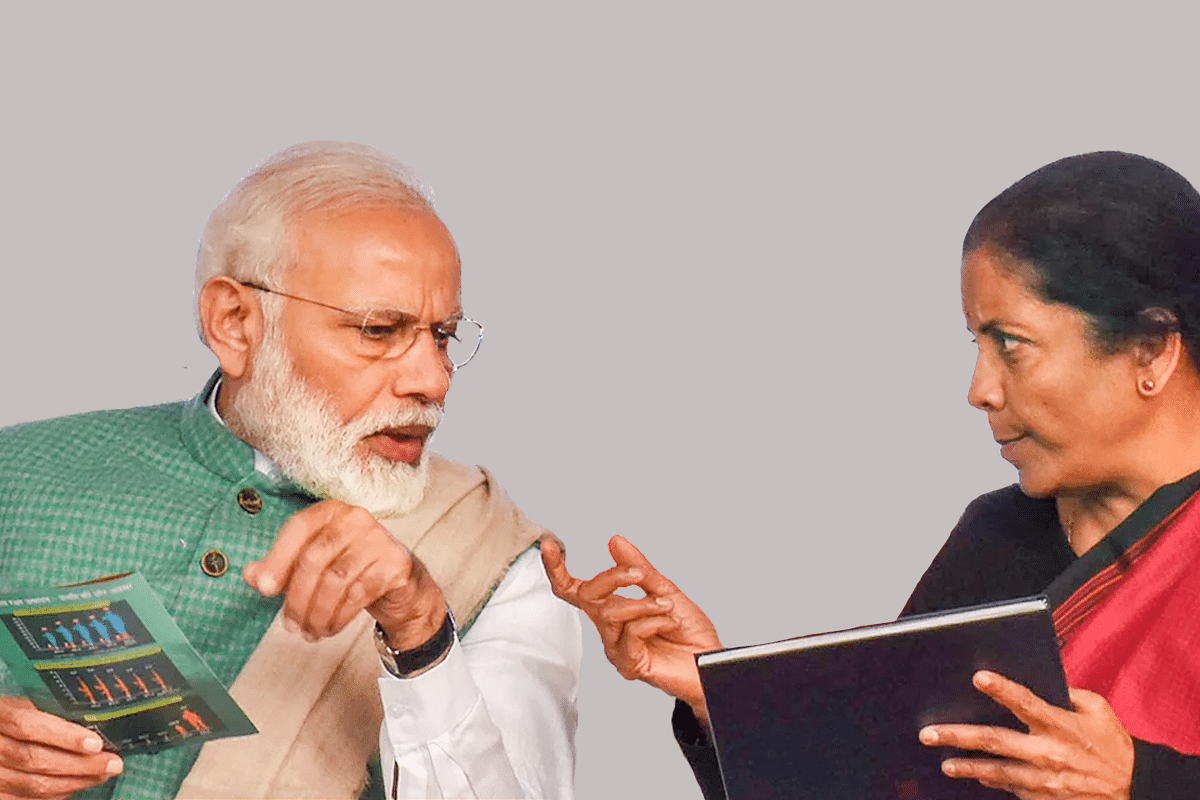Economy
Don't Sweat The Q1 GDP Data: India Is Still The Only Game In Town Among Big Economies
- The Q1 GDP growth is nothing to lament. We are still the only game in town among large economies.
- The US and European Union are staring at possible recession, and China is into a full-blown slowdown and real estate and infrastructure crisis.

Prime Minister Narendra Modi with Finance Minister Nirmala Sitharaman.
Over the second term of Narendra Modi, economic performance in the first quarter (Q1, April-June) has become a dicey affair.
In 2019, it was impacted by general election spends; in 2020, it was the draconian Covid lockdowns.
In 2021, it was the frightening Delta wave; and this year’s performance has been disrupted by the Russia-Ukraine war that began around the end of February and continues even today.
The consensus opinion among data-watchers is that the reported Q1 GDP (gross domestic product) growth of 13.5 per cent for April-June 2022 is less than anticipated.
They apparently had pencilled in 15-16 per cent. But any projection is only as good as the assumptions that underlie them.
What the number-crunchers failed to account for was the serious economic disruption caused by the Russia-Ukraine war.
To name just a few of them: commodity prices, especially crude oil and gas, went through the roof; food prices spiked; and so did input costs across a wide range of industries.
Governments, in order to protect consumers, were weighing in with restrictive policies.
In India, we saw the government cutting taxes on fuel, ban wheat exports, and imposing export duties on some steel products, among other things.
This implies that Q1 was the period when producers of goods and services and consumers were adjusting to higher prices.
While producers were trying to avoid passing on their entire cost increases to prevent a demand shock for consumers, consumers may have held back a bit on buying some things in order to wait for prices to settle.
Given the disruptions, Q1, which reported GDP growth of a phenomenal 13.5 per cent at constant prices (albeit on a lower base in 2021-22), and gross value added (GVA, which is GDP minus taxes and plus product taxes), at 12.7 per cent, is actually a standout performer.
The story is really in inflation — as reflected in the GDP growth in nominal terms, which was a super-normal 26.7 per cent.
This implies that the GDP deflator, an economist’s estimate of system-wide price impact encompassing both goods and services, including intermediate goods and services, was as high as 13.2 per cent.
The real GDP is calculated from nominal GDP at current prices by deducting the inflation impact as measured by the deflator.
Contrast the high deflator with July’s Consumer Price Index (CPI) inflation of 6.7 per cent and Wholesale Price Index (WPI) of 13.93 per cent.
The deflator was thus reflecting the broader inflation at the wholesale level rather than at the consumer level, and the three measures of inflation will take some time to start converging.
But here’s the good news: in India, economic growth has usually been associated with rising inflation (consider 2004-2012), and the current bout of inflation indicates not just supply dislocations, but also shifts in pricing power which feed into a need for fresh investment as existing capacities get used up.
The other good news is in the sectoral detail. All sectors are now in growth mode, some more than others.
The sectors growing particularly well are electricity, gas and water and utilities (up 14.7 per cent in terms of GVA), trade, hotels, transport, communications, etc, at 25.7 per cent, construction (16.8 per cent), financial, real estate and professional services at 9.2 per cent, and public administration and defence at 26.3 per cent.
Agriculture, too, is doing much better than last year, growing 4.5 per cent in Q1 GVA against 2.2 per cent last year.
The story of Q1 is the return of contact-based services, impacted the most by Covid restrictions, back to the growth path.
The weak spot is manufacturing, which grew by an underwhelming 4.8 per cent in terms of GVA, but that is on a huge jump of 49 per cent in Q1 2021-22.
The base effect is showing, and so is the adjustment to the Russia-Ukraine war disruptions.
Net-net, Q1 GDP growth is nothing to lament, despite missing some expectations of analysts.
We are still the only game in town among large economies, with the US and European Union staring at possible recession, and China into a full-blown slowdown and real estate and infrastructure crisis.
Little wonder, the stock markets are refusing to give up hope despite headwinds from abroad.
Support Swarajya's 50 Ground Reports Project & Sponsor A Story
Every general election Swarajya does a 50 ground reports project.
Aimed only at serious readers and those who appreciate the nuances of political undercurrents, the project provides a sense of India's electoral landscape. As you know, these reports are produced after considerable investment of travel, time and effort on the ground.
This time too we've kicked off the project in style and have covered over 30 constituencies already. If you're someone who appreciates such work and have enjoyed our coverage please consider sponsoring a ground report for just Rs 2999 to Rs 19,999 - it goes a long way in helping us produce more quality reportage.
You can also back this project by becoming a subscriber for as little as Rs 999 - so do click on this links and choose a plan that suits you and back us.
Click below to contribute.
Latest